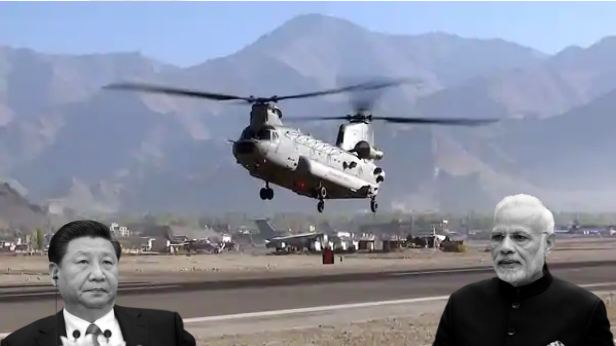To counter China on the border, an aggressive India under Prime Minister Narendra Modi is gearing up to build four new airports and 37 helipads across the Union Territory of Ladakh. According to an ET report, the process of land identification and preliminary discussions have been concluded and the next stage would be a joint report by key stakeholders like the DGCA, Airports Authority of India and the Indian Air Force.
Land for four new airports, fit for the landing of wide-body aircraft has been completed while the government plans on an alternative airfield for the town of Leh and a direct link to the Zanskar valley. However, the most important region where the government has taken the battle to China is by planning an airfield in Changtang, which links directly to Pangong Tso lake, one of the ground zero of the conflict last year that erupted after the clashes in the Galwan valley.
The PLA troops were moved by the CCP near the border which led to escalation for several months on the trot with Indian forces occupying decisive heights and ultimately forcing Beijing to drop the towel and retreat.
Moreover, 37 helipads are currently under construction across Ladakh, with most of them expected to be operational by the year-end. These helipads will be capable of even handling the heavy Chinook CH 47 helicopters.
Not only will the key air links help in serving the wider military requirements of moving the troops, resources and arsenal to the desolate regions of the border, it will also help in boosting tourism in the Union Territory as the government attempts to grant civil operations to few of the airports. Moreover, the airports and helipads will help enhance connectivity with the road network the government is developing across the Union Territory to make it much more accessible.
Reported by TFI, the Indian government has been working in an overtime mode to counter any Chinese threat in the region. In a historic shift last month, at least 50,000 troops were redirected to the border taking India’s total troop tally to well over 2,00,000 — signalling an increase of more than 40 per cent from last year.
The number of troops has also been increased along the southern Tibetan plateau, with soldiers equipped with machine guns having joined the retinue of armed paramilitary personnel already stationed there.
Read more: More warships and more troops: China faces a very aggressive India on the Indo-Tibetan border
Rattled by India’s offense in the region, China, through its mouthpiece, Global Times published a haphazard op-ed and tooted horn of its own might. The editorial read, “India should stop political manipulation and make efforts to realize full disengagement at an early date, as China’s will to cherish peace and its military strength are both stronger than India’s.”
India to this day claims Aksai Chin as a part of its own territory. To the same effect, Defence Minister Rajnath Singh, while addressing the Rajya Sabha last year had iterated, “China continues to be in illegal occupation of approximately 38,000 sq. kms in the Union Territory of Ladakh.” he said whilst adding, “In addition, under the so-called Sino-Pakistan ‘Boundary Agreement’ of 1963, Pakistan illegally ceded 5,180 sq. km of Indian territory in PoK to China. China also claims approximately 90,000 sq. kms of Indian territory in the Eastern Sector of the India-China boundary in Arunachal Pradesh.”
Similarly, Home Minister Amit Shah had echoed similar sentiments when it came to Kashmir and Aksai Chin. The Minister had famously remarked, “We’re ready to give our lives for it”. He added, “Kashmir is an integral part of India, there is no doubt about it. When I say Jammu and Kashmir, I include Pakistan Occupied Kashmir and Aksai Chin, both are included in the territorial boundaries of Jammu and Kashmir.”
It was New Delhi’s newfound stance on Ladakh and Aksai Chin that a beleaguered China was forced to ramp up escalation on the border to satiate the jangling nerves of few in the CCP politburo. However, after India’s aggressive infrastructure development plans in the region, it will be interesting to observe how Xi Jinping and his lackeys react to it.
